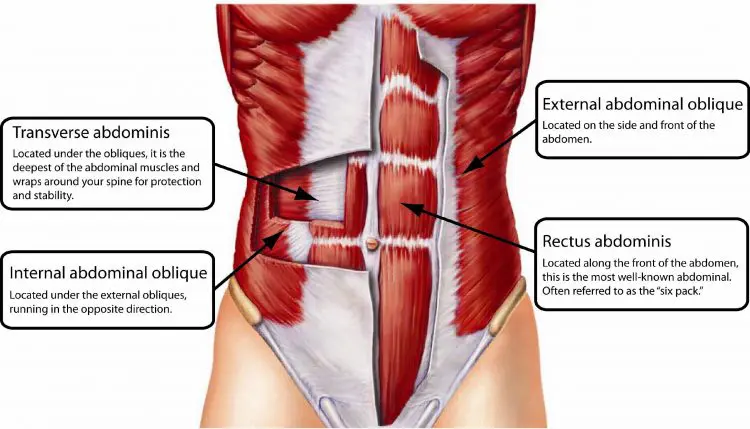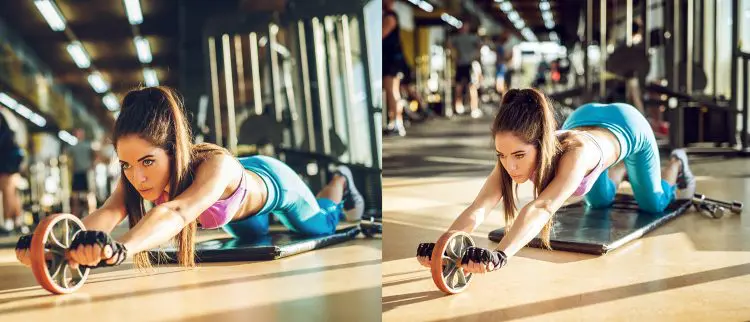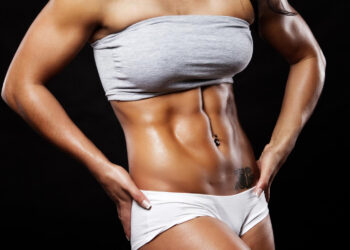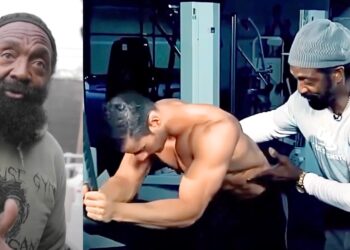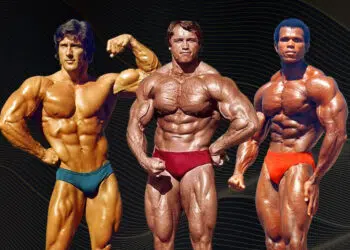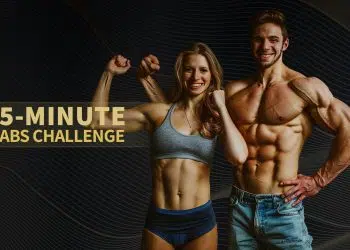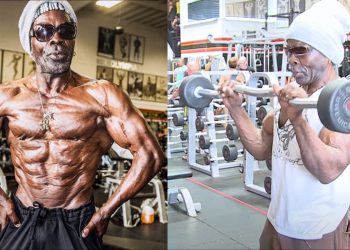It’s no coincidence that some of the best, most popular abs exercises require nothing more than your body weight. Whether you are lifting your head and shoulders or your legs, your body weight provides a useful source of resistance, so you can train your abs almost anywhere and anytime.
Yes, you can use things like dumbbells, kettlebells, medicine balls, and cable machines to train your abs but, sometimes, simple is best, and your body weight is all you need. That’s especially true if you want to sneak in a home abs workout when you don’t have time to go to the gym.
There are dozens if not hundreds of bodyweight abs exercises to choose from, and yet, most people tend to gravitate toward the same old sit-ups, crunches, and planks. And while there is nothing wrong with these exercises, they can lose their potency if you do them too often. Plus, doing the same old thing over and over can become boring, too.
In this article, we lift the lid on in and outs, sometimes called seated tucks and in ‘n’ outs, which are another convenient bodyweight abs exercise.
In and Outs Muscles Worked
In and outs are generally thought of as an abs exercise; however, several additional muscles are involved in this movement:
Level Up Your Fitness: Join our 💪 strong community in Fitness Volt Newsletter. Get daily inspiration, expert-backed workouts, nutrition tips, the latest in strength sports, and the support you need to reach your goals. Subscribe for free!
Rectus abdominis – the rectus abdominis is the large, flat muscle on the front of your abdomen. It’s the agonist or prime mover during in and outs and why most people do this exercise. The main function of the rectus abdominus is the flexion of your spine.
The rectus abdominus is divided into segments by ligamentous tissue called the linea alba, which is what gives it that distinctive six-pack appearance. However, this is only visible when you are very lean.
Transverse abdominis – where the rectus abdominis runs vertically up the front of your abdomen, the transverse abdominis runs horizontally. It helps stabilize your spine by contracting inward to generate intra-abdominal pressure, or IAP for short.
Obliques – the obliques are basically your waist muscles. Their main function is the rotation and lateral flexion of your spine. During in and outs, they mostly work as stabilizers to prevent unwanted movement. However, there are variations that target your obliques more directly.
Iliacus and psoas major – collectively known as the iliopsoas, these muscles flex your hips. While not abdominal muscles, the Iliacus and psoas major are very active during in and outs.
Rectus femoris – the rectus femoris is one of your quadriceps muscles. It works alongside Iliacus and psoas major top flex your hips during in and outs.
How To Do In and Outs
Get the most from in and outs while keeping your injury risk to a minimum by following these instructions:
- Sit on the floor with your legs bent and feet flat. Sit up, so your upper body is close to vertical.
- Put your hands on the floor next to your hips for balance if necessary.
- Brace your abs and lift your feet a few inches off the floor.
- Extend your legs out in front of you, leaning back to maintain your balance.
- Bend your legs and bring your knees back into your chest, leaning forward at the same time. Do not let your feet touch the floor.
- That’s one rep; keep going!
In and Outs Benefits and Drawbacks
In and outs are a valuable abs exercise with several notable benefits:
Anywhere, anytime – with no equipment required, you can do this exercise almost anywhere and anytime. Because you sit on your butt rather than lie on the floor, you don’t even need an exercise mat to do this movement in comfort.
Upper and lower abs – while there is no such thing as upper abs or lower abs muscles, you can initiate an abdominal contraction by lifting your head and shoulders OR your hips. In and outs involve both of these movements, making them a very comprehensive abs workout.
Simple to perform – in and outs are not especially complicated, which makes them easy to learn. They’re also useful for things like abs circuits and high-intensity interval training when you need an exercise that doesn’t require too much thought and can be done with very little preparation.
Works your abs and hip flexors – a lot of abs exercises only work rectus abdominis, but in nature, your abs often work with your hip flexors, e.g., when kicking, punching, or throwing. This means that in and outs are more functional than many more isolated movements like crunches.
While in and outs are mostly beneficial, there are a few drawbacks to consider too:
Lower back strain – the Iliacus and psoas major attach onto your lumbar vertebrae and can pull your spine into an overly extended position. A strong transverse abdominis should stop this from happening, but if you have weak deep core muscles or suffer from hyperlordosis (an abnormally large lower back arch), in and outs could put a lot of stress on your lower back, leading to back pain or injury.
Level Up Your Fitness: Join our 💪 strong community in Fitness Volt Newsletter. Get daily inspiration, expert-backed workouts, nutrition tips, the latest in strength sports, and the support you need to reach your goals. Subscribe for free!
Limited overload – initially, lifting your legs should provide the target muscles with an effective workout but, as you get stronger, you may find that the only way to challenge your abs is to do more and more reps. High rep abs training is not very time-efficient and won’t do much to further strengthen your abdominal muscles.
7 In and Outs Alternatives and Variations
Whether you’ve tried in and outs and didn’t like them, find that they’re not challenging enough, or have done them so often that you’re becoming bored of them, here are seven variations and alternatives to try.
1. Bench in and out
While the floor version of in and outs is a fine way to work your abs, doing them on a bench may be more comfortable and allows you to alter the angle of your body. You can also use a larger range of motion.
How to do it:
- Sit on the edge of a flat exercise bench, legs extended in front of you, heels on the floor. Lean back and grip the sides of the bench next to your hips for balance. Brace your abs and lift your feet a few inches off the floor.
- Bend your legs and pull your knees toward you while simultaneously leaning your upper body forward.
- Extend your legs and lean back again to maintain your balance.
- Continue for the desired number of repetitions.
1. Twisting in and out
During basic in and outs, your obliques work mostly as stabilizers to prevent unwanted side-to-side movement. In this variation, your obliques are much more active, making this a more complete midsection workout.
How to do it:
- Sit on the floor with your legs bent and feet flat. Sit up, so your upper body is close to vertical.
- Brace your abs and lift your feet a few inches off the floor. Put your hands on the floor next to your hips for balance if necessary.
- Extend your legs out in front of you, leaning back to maintain your balance.
- Bend your legs and bring your knees diagonally across toward one shoulder, leaning your weight over onto one hip.
- Extend your legs and repeat, alternating sides rep by rep.
3. Reverse crunch
If in and outs bother your lower back, reverse crunches may be the next best exercise. Like in and outs, you can do this movement almost anywhere and anytime, but it works your abs without extending your hips, taking tension off your iliacus and psoas major.
How to do it:
- Lie on your back with your knees bent to 90-degrees and thighs vertical. Place your arms flat on the floor for balance.
- Flex your abs, lift your hips off the floor, and curl your knees toward your shoulders. Do not use momentum. Instead, move slowly and deliberately to maximize muscle activation.
- Return to the starting position and repeat.
4. Bicycle crunch
Bicycle crunches are a lot like in and outs, but you’ll be extending one leg at a time and twisting to increase oblique involvement. Most people find this exercise a little more lower back-friendly than standard in and outs.
How to do it:
- Lie on your back with your legs straight, hands on your temples. Brace your abs and lift both legs a few inches off the floor. Flatten your lower back.
- Lift your upper body, bend one leg, and pull your knee in toward your chest. Simultaneously lift your upper body and twist to take your elbow across to meet your incoming knee.
- Extend your leg, lower your upper body, and repeat on the opposite side.
- Continue alternating sides for the required number of reps.
5. Captain’s chair bent knee raise
Like in and outs, the captain’s chair bent knee raise works your hips flexors and abs at the same time. Plus, with your body vertical instead of horizontal, it affects the target muscles quite differently, adding some welcome variety to your abs workout.
How to do it:
- Support your weight on your elbows and let your legs hang straight down. Press your shoulders down and back to stabilize and protect your shoulder joints.
- Bend your legs and raise your knees to above hip height. Lift your lower back away from the pad to maximize abdominal recruitment.
- Lower your legs and repeat.
- No captain’s chair? You can also do this exercise hanging from a pull-up bar.
6. V-sit
V-sits are an advanced version of in and outs. Like in and outs, they involve moving your upper and lower body simultaneously. However, with longer levers and a bigger range of motion, they are a whole lot more challenging.
How to do it:
- Lie on your back with your legs straight and arms extended above your head. Your feet should be a few inches off the floor, knees pressed together.
- Contract your abs and lift your legs and upper body at the same time, reaching up toward your toes. At this point in the exercise, you should be balancing on your butt and lower back.
- Lower your arms and legs and repeat.
7. Abs wheel rollout
To the uninitiated, in and outs might not look much like abs wheel rollouts, but they actually use all the same muscles. However, with this exercise, instead of lifting your legs, you’ll be using your abs and hip flexors to lift your body, making them considerably more demanding. You can do rollouts from a kneeling or standing position and using a barbell instead of an abs wheel.
Learn more about this great abs exercise here.
In and Outs – Wrapping Up
If you want a firm, toned midsection, in and outs could help. Because they are a simple bodyweight exercise, you can do them almost anywhere and anytime, making them ideal for home workouts.
However, despite their simplicity, in and outs still offer an effective workout, and they’re straightforward to learn and easy to master. Use in and outs, and the seven variations and alternatives in this article, to sculpt the midsection of your dreams.
Interested in measuring your progress? Check out our strength standards for Sit Ups, Reverse Crunches, Bicycle Crunch, and more.

